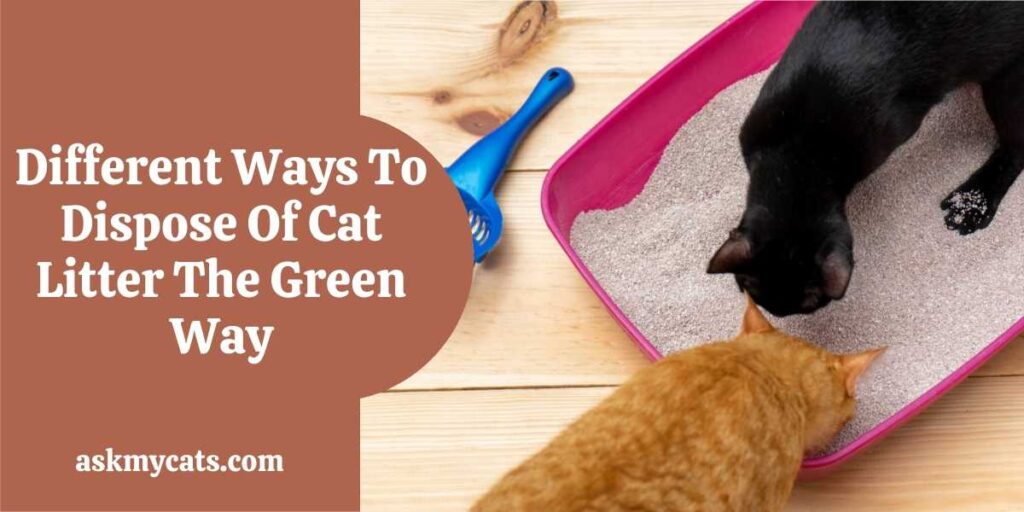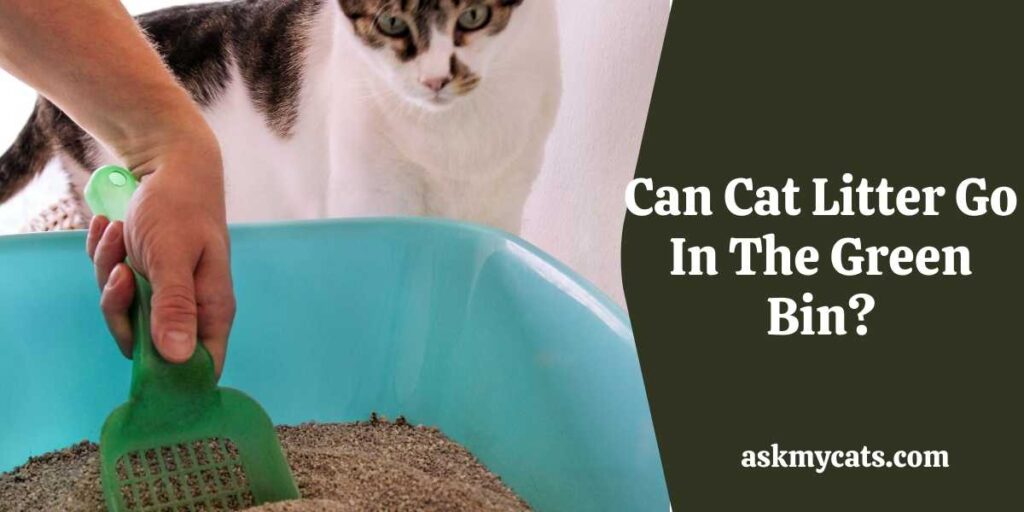There are several green and eco-friendly ways to dispose of kitty litter, each with its own set of benefits and drawbacks.
No solution will work for everyone because of the vast diversity of cat litters, the varying wastewater treatment and sewer infrastructures in each municipality, and the difficulties in composting cat feces.
The simplest and most eco-friendly way to dispose of cat waste is to scoop it out of the box, carefully wrap it in a bag, and dump it in the garbage. The most environmentally friendly approach to cat excrement is composting it.
However, there are environmentally friendly ways to dispose of cat waste and litter.
Cat owners may lessen their eco-paw print and dispose of their kitty’s waste in a less detrimental way to the environment with suitable materials and a little know-how.


Give Your Cat the Perfect Day
Get the Free Ebook!
How To Dispose Of Cat Litter Environmentally Friendly?
Composting cat litter is one of the most environmentally beneficial methods to dispose of it. The second most environmentally responsible approach is to use biodegradable kitty litter and dispose of it in the garbage. It will naturally biodegrade in the landfill (without using plastic bags).

1. Composting
Composting your kitty litter can be a good idea if you have a garden and love working in it. You’ll need to get a compost heap if you don’t already have one.
Compost containers are simple to construct, purchase, or upcycle. If you opt to make it, all you’ll need is a wooden box that looks like a raised flower bed and has enough area for your growing heap as well as enough room to turn it regularly.
You’ll have to put your cat’s feces on the mound as well. If the litter is clay-based, sand-based, or crystalline, you should not use it since it will not biodegrade.
Compostable cat litter, such as sawdust or natural pine shavings, is ideal for use in the composting process. Make sure to compost your cat’s litter far from edible plants, veggies, or fruits.
2. Do Not Flush Cat Litter
Because of the possibility of contamination with the bacterium Toxoplasma gondii, flushing your cat’s litter is not an environmentally beneficial approach to dispose of your cat’s litter.
Most indoor cats that eat a well-balanced dry and wet food diet won’t get infected, but outdoor cats who consume raw meat, such as birds or mice, can get the bacterium and develop toxoplasmosis.
If your cat’s excrement is infected, it can contaminate our rivers, resulting in the loss of marine species. Not to mention the fact that it may make us people sick.
Different Ways To Dispose Of Cat Litter The Green Way

1. Using a Trash Can
Using a trash can is one of the most prevalent ways to dispose of litter. Most towns already have a system for appropriately classifying garbage, so this would be a safe and responsible solution.
We recommend taking a few precautions before putting a bag of soiled cat litter into the garbage.
2. Purchase Heavy-duty Bags
A ripped garbage bag and spilt cat litter are two things you’ll want to avoid. Investing in heavy-duty garbage bags is the best way to avoid such problems, especially if you’re using clay kitty litter.
Because clay-based litters are thick, they can easily strain and rip a conventional garbage bag.
Consider doubling up your bags if heavy-duty bags are not in your budget or if you want to utilize the bags you already have. When hauling dense litter, this method might give additional assistance.
Suppose you have numerous cats who share a litter box or multiple boxes. In that case, it’s still a good idea to use a thick trash bag or double-up thinner bags because the overall volume of litter you’ll be removing will be considerably greater.
3. Use Trash Bag
You’ve tried holding a trash bag in one hand while pouring litter into it with the other, which generally results in another mess to clean up.
Purchasing a specialized litter garbage container is a quick and easy option. Place your trash bag inside the container so that you can transfer the rubbish with both hands.
The can will act as structural support for the bag while keeping it open and stable. You should make a seamless transition without worrying about spills that are both unneeded and unclean. You’re done! Tie off before taking up.
4. Separate Trash Can
We recommend that you acquire a separate garbage bin for your spent litter for sanitary reasons.
While it is OK to combine the litter with organic trash (manure or anything biodegradable), this precludes the possibility of repurposing your organic waste or compost in other ways, such as gardening.
Litter is frequently harmful trash since it isn’t composting or biodegradable. You will make it simpler for garbage collectors to accomplish their duty of properly segregating rubbish, separating those that might harm persons or the environment.
You should tie up your bag, remove it from your trash can, and start a new bag for your next scoop session every time you dump a complete batch of old litter (total litter replacement, not daily scoops!).
This will assist minimize smells and guarantee that your garbage bag isn’t set up for rips from the inevitable heavyweight.
On a related point, you shouldn’t leave spent litter or daily scoop waste in an open trash bag for too long. Regular disposal will help keep the environment clean and sanitary and prevent new germs from growing in contaminated trash.
You risk inviting house flies and nasty trash scents into your home if you don’t take these precautions.
5. Compost Cat Litter
Because most cat litters are not made from biodegradable materials, composting cat litter is not always an option. When buying litter, though, search for companies that claim to be biodegradable or comprised of organic ingredients.
If you’re not acquainted with composting, it’s a method for turning organic matter into nutrient-rich soil. Rather than throwing these litters in the garbage, you may compost them and convert them into fertilizer.
You will be contributing to a greener environment by using biodegradable and compostable litter. Plus, you may create a natural fertilizer by composting biodegradable waste instead of relying on a chemical-laden commercial alternative. It’s a win-win situation!
6. Flushing Cat Waste
What if you could flush your cat’s solid waste down the toilet? While this is the simplest option, we don’t advocate it unless the brand has been proven flushable and you’ve checked with your municipality for any flushing limitations.
Side note: dumping unauthorized garbage down the toilet may contaminate your waterways and possibly cause pipe clogs, which can be pretty expensive to clean.
You should first become familiar with the types of flushable litter before deciding on this strategy.
Can Cat Litter Go In The Green Bin?
Yes, cat litter can go in the green bin.

In the green bin, only cat litter made entirely of paper or sawdust and certified as biodegradable by the Australian Standard AS 4736 with this sign is allowed.
If your cat litter comprises stone, clay, or crystals/silica, put it in the general waste/landfill container (blue or red lid) rather than the green bin.
Before putting pet trash in your green bin, we recommend wrapping it in a newspaper or collecting it in a biodegradable container.
This will assist in keeping your bin clean and preventing foul odours. Please do not use plastic or biodegradable bags since they will contaminate the area.
Frequently Asked Questions
Can you put cat litter in the garden waste bin?
Cat litter (even if labeled as biodegradable) should not be placed in your recycle or garden trash receptacle since it might be dangerous during processing.
How do you get rid of sustainably cat poop?
Using a litter scooper, scoop the clumps of litter. Place the scooped clumps in a garbage bag that is thick or double-layered. Close the bag securely to keep the litter secure and smells at bay. Place the bag in an outside garbage can to eliminate germs, smells, and bacteria from your home.
How long does it take for cat poop to decompose?
Using the cold composting method, it will take at least a year to compost leftover cat litter. Hot composting might take as little as a few months, but you’ll have to put in a bit more work.
Final Words
You may still be ecologically careful with your cat’s waste disposal if you don’t want to go to the extra work of composting your litter or don’t have the space to do so.
Even if it is not compostable, purchasing sustainable, biodegradable trash is a viable alternative.
